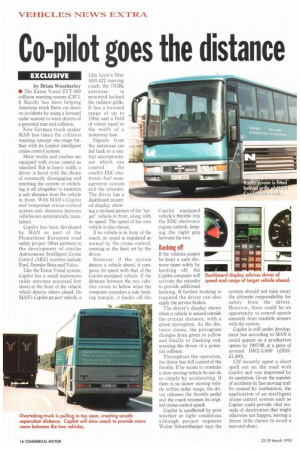Co-pilot goes the distance
Page 18

If you've noticed an error in this article please click here to report it so we can fix it.
EXCLUSIVE
by Brian Weatherley
• The Eaton Vorad EVT-200 collision warning system ((.TM 28 March) has been helping American truck fleets cut down on accidents by using a forward radar scanner to warn drivers of a potential rear end collision.
Now German truck maker MAN has taken the collision warning concept one stage further with its Copilot intelligent cruise control system.
Many trucks and coaches are equipped with cruise control as standard. But in heavy traffic a driver is faced with the choice of constantly disengaging and resetting the system or switching it off altogether to maintain a safe distance from the vehicle in front. With MAN's Copilot and tempomat cruise-control system safe distances between vehicles are automatically maintained.
Copilot has been developed by MAN as part of the Prometheus European road safety project. Other partners in the development of similar Autonomous Intelligent Cruise Control (AICC) systems include Ford, Daimler-Benz and Volvo.
Like the Eaton Vorad system, Copilot has a small microwave radar antenna mounted low down at the front of the vehicle which detects others ahead. On MAN's Copilot project vehicle, a 12m Lion's Star A03.422 touring coach, the 77GHz antennae is mounted behind the radiator grille. It has a forward range of up to 150m and a field of vision equal to the width of a motorway lane.
Signals from the antennae are fed back to a central microprocessor which can control the coach's EDC electronic fuel management system and the retarder. The driver has a dashboard mounted display showing a stylised picture of the "target" vehicle in front, along with its speed. The speed of his own vehicle is also shown.
If no vehicle is in front of the coach, its speed is regulated as normal by the cruise control, running at the limit set by the driver, However, if the system detects a vehicle ahead, it compares its speed with that of the Copilot-equipped vehicle. If the distance between the two vehicles closes to below what the computer considers a safe braking margin, it backs off the Copilot equipped vehicle's throttle (via the EDC electronic engine control), keeping the right gap between the two.
If the vehicles cannot be kept a safe distance apart solely by backing off, the Copilot computer will activate the retarder to provide additional braking. If further braking is required the driver can also apply the service brakes.
The driver's display shows when a vehicle is sensed outside the critical distance, with a green pictogram. As the distance closes, the pictogram changes from green to yellow and finally to flashing red, warning the driver of a potential collision.
Throughout the operation, the driver has full control of the throttle. If he wants to overtake a slow moving vehicle he can do so simply by accelerating. If there is no slower moving vehicle within radar range, the driver releases the throttle pedal and the coach resumes its original cruise control speed.
Copilot is unaffected by poor weather or light conditions although project engineer Walter Schwertherger says the
Maw—
system should not take away the ultimate responsibility for safety from the driver. However, there could be an opportunity to control speeds remotely from roadside sensors with the system.
Copilot is still under development but according to MAN it could appear as a production option by 1997/98, at a price of around DM2-3,000 (.C925£1,400).
CM recently spent a short spell out on the road with Copilot and was impressed by its operation. Given the number of accidents in fast-moving traffic caused by inattention, the application of an intelligent cruise control system such as Copilot could provide vital seconds of deceleration that might othenvise not happen, leaving a driver little chance to avoid a rear-end shunt.




































































































